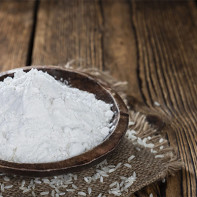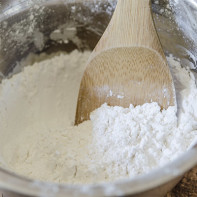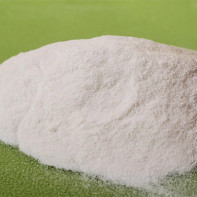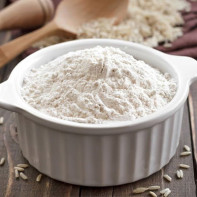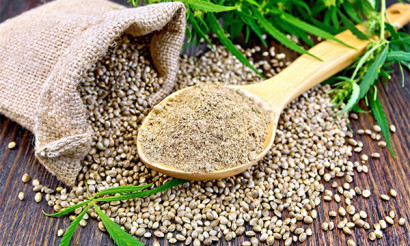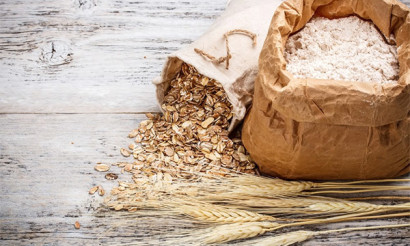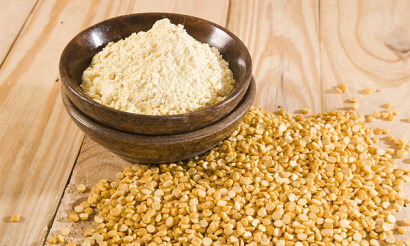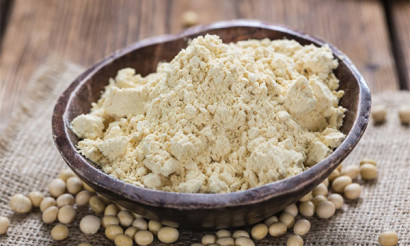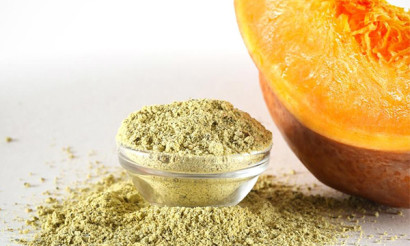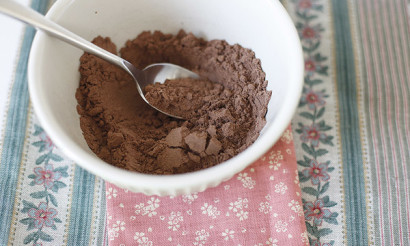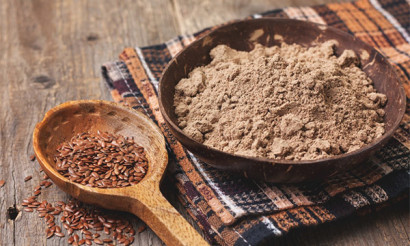Rice flour: useful properties and contraindications
A slight change in the recipe can dramatically transform the dish, so if you are tired of the monotony in the menu or you want to improve the body, try to replace the usual wheat flour with a rice counterpart. This product is recommended for those who are allergic to gluten, as well as those who want to lose extra pounds. Rice flour is rich in vitamins and nutrients while being light and pleasant to digest. Learn more about this unusual product in our article.
- Types of rice flour
- How rice flour differs from wheat flour
- Which flour is better: rice or corn flour
- Composition and calories
- What is Rice Flour Good for?
- Rice flour in baby food: benefits or harms
- Benefits and Harms of Rice Flour for Weight Loss
- Rice Flour in Medicine
- Diabetes Mellitus
- In pancreatitis
- Rice Flour in Cosmetology
- Harms and Contraindications
- How to Make Rice Flour at Home
- How to Choose and Store Rice Flour
- What can be made of rice flour: Recipes
- Gluten-free rice pancakes
- Cheese Crepes for Vegans
- Pancakes
- Banana Cakes
- Rice Facts
Types of Rice Flour
Flour is made at home and industrially, using different varieties of rice for this purpose. White and brown flour, which are made, respectively, from ground and bran rice, are fundamentally different. The caloric value of this product is virtually the same, but the nutritional composition is different. Brown rice flour contains more valuable minerals, amino acids and oils. Such a product is usually considered a dietary supplement, it is cautious and short-lived, and also has an order of magnitude higher cost.
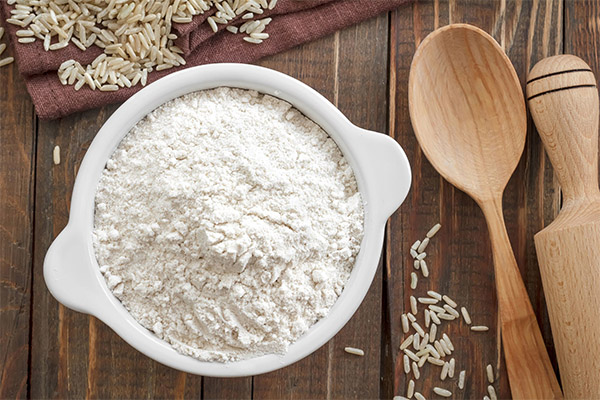
White rice flour is more hardy and stable, nevertheless it also has excellent nutritional qualities, so it is not necessary to buy the brown delicacy product regularly at all. You can alternate between different kinds of rice flour in your diet to enrich your body with a supply of B vitamins and minerals to improve well-being, cleanse and revitalize.
How rice flour differs from wheat flour
One of the main advantages of rice flour over wheat flour and other white grains is the absence of gluten. According to recent studies, gluten causes intestinal irritations in a large number of people, according to various sources from 80 to 98% of the world's population.
People suffering from celiac disease - gluten intolerance - make up only 1% of the population (but this figure is also due to the fact that the disease is almost never diagnosed in Russia, CIS countries, Africa and a number of other countries). But even those who are able to digest wheat components are susceptible to sensitivity and experience discomfort.
Gluten and similar proteins destroy intestinal villi, preventing the normal absorption of useful elements. This can lead to the formation of toxins, metabolic disorders, and a deterioration in health. Gluten often causes bloating, itching and burning sensations, and slowed peristalsis. There is no such protein in rice, besides, it has a minimal amount of potential allergens, so rice flour is considered a dietary and safe food.
In addition, rice flour contains fewer calories, is more rapidly digested and produces a sorbent effect, so it can improve well-being in diarrhea and poisoning, gastritis and other digestive disorders, in the diet of the elderly and on diets for weight loss.
Which flour is better: rice or corn flour
Everyone who advocates a healthy diet and seeks to cleanse the body, you can safely introduce both of these analogues of wheat flour into the diet. Unlike oats, rye, barley and wheat, succulent corn grain and rice do not contain gluten or similar proteins, so they do not irritate the gut or upset the metabolism.
However, corn can also cause allergies, whereas rice is one of the safest grains for the body. Rice has a sorbent effect, preventing diarrhea and poisoning, in addition, it contains fewer calories and promotes weight loss. Baking with rice flour is actually not harmful to the figure, quickly and easily digested without causing heaviness and discomfort.
Rice contains less fat unlike corn, and its only advantage is the presence of gold in its composition. Usually it is the rice cereal that is recommended on therapeutic and preventive diets even for inflammatory diseases.
From the culinary point of view it is more comfortable to work with corn flour: it contains more starch, has a higher degree of viscosity when soaked and yet remains dietary. Corn flour makes excellent baked goods in all formats, from cookies to cakes. Therefore, rice flour and corn flour are often mixed in recipes for healthy eating, and which one is better is a relative question: each product is good in its own way.
Composition and Calories
Like other cereal products, rice flour has a high caloric value of about 360 kcal/100g. Depending on the type of rice, this figure may vary slightly. It is impossible to name rice grind unequivocally harmless for a figure, because grits and flour contain about 80 grams of carbohydrates, therefore it is necessary to consume such product in moderate quantity - only then the grain benefit will not bring side effects in the form of fat deposits.
Rice flour contains about 6 g of protein and up to 1.5 g of fat, in brown flour these indicators are only 1-1.5 g higher, while the level of carbohydrates is lower - 76 g.
Brown flour contains many more valuable amino acids and oils that are essential for proper body function. Both products have a high concentration of B vitamins involved in the formation of immunity and healthy metabolism, the normal functioning of internal organs. Rice is also rich in vitamin E, which is needed to maintain water balance and healthy skin and to exert antioxidant and cleansing effects.
Nevertheless rice is not rich in all vitamins: both white and brown flours lack vitamins A and C, which the body needs all the time, that's why experts recommend not to stick to mono-diet based on rice, but to consume it in combination with other healthy foods to provide the body with everything it needs.
Rice flour also contains copper and iron, calcium, potassium, magnesium and phosphorus, zinc manganese and selenium. The high content of copper and ferrum allows effectively regulate the cardiovascular system and provide the body with the necessary blood volume.
Rice flour has a much lower protein content than other cereal powders. Therefore, in sports nutrition and pregnancy, it should definitely be combined with protein foods.
What is the usefulness of rice flour
The main advantage of rice grain is its sorption effect. Rice removes poisons and toxins, undigested food debris, products of protein and fat decomposition, excess fluids and even radionuclides from the body more effectively than other cereals. In the form of flour this cereal has a massaging effect on the intestinal walls, activating blood flow and improving the digestive process.
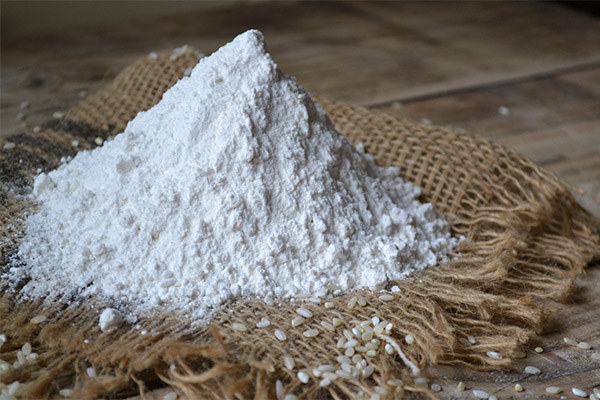
Rice is used in the diet for many diseases:
- For treatment of the liver and prevention of fibrosis, excretion of processed foods and cleansing.
- For gastritis, diarrhea, flatulence and other digestive disorders, including gluten intolerance. Rice is the most gentle grain of its congeners, does not irritate the mucous membranes of the internal organs, has an enveloping effect, is easily digested without causing heartburn and bloating, feelings of heaviness and other discomfort.
- For varicose veins and swelling. This flour is able to remove excess fluid from the body and protect the blood vessels, making them more elastic and strong.
- For heart disease, hypertension and atherosclerosis, rice flour will help to remove cholesterol, strengthen the heart muscle, normalize blood flow and improve tissue health.
- Rice also helps to cleanse the skin, relieve irritation, smooth out scars and irregularities, maintain water balance, remove traces of fatigue and chronic stress.
- Such flour will help strengthen bones, joints, nails and hair.
- In diets, rice promotes rapid satiety, while the "long" carbohydrates in its composition are digested slowly, fueling the body with energy for a long time.
Rice is not recommended to include in the diet in large quantities with a sedentary lifestyle, but with constant activity it helps to regulate appetite and replenish strength. Rice flour is introduced into the diet of children and the elderly because of its hypoallergenic properties.
The main healing properties of rice are considered to be:
- Adsorption of negative elements, salts of heavy metals and toxins. Therefore, it is consumed during colds, after poisoning, alcohol consumption or a long course of antibiotics. Usually in such cases, it is combined with probiotics, fermented dairy products, chicken broth, healthy fruits and vegetables. It gently removes poisons from the body without overloading the weakened digestive system and allowing a faster recovery.
- Removing excess fluid from the body, removing edema.
- Protection of the digestive system from disorders. Rice has no gluten, gluten and similar proteins, so it does not cause fermentation, gas and discomfort in the intestines. Rice flour can be added to the food of children with still very sensitive intestines, the elderly and patients with pancreatitis, who may experience discomfort from heavy food.
- When used externally, rice can deeply clean pores, give an exfoliating and whitening effect, reduce the oiliness of the scalp and face, control sebum function, absorb unpleasant sweat odor and nourish skin and hair follicles, preserving life-giving moisture. Therefore, rice flour is often used in home and salon cosmetology around the world.
Rice flour in children's food: benefit or harm
Rice products can be given to children in order to facilitate digestion. Dietitians necessarily recommend to diversify children's diets, and in the first years of life to dilute the wheat and other components just rice flour.
Asian countries and the West have long been using rice flour as a safe thickener in baby formula. Domestic manufacturers have also gradually begun to support this trend due to new research on the effects of cereals on the body and the growing number of allergic people.
Rice flour can be introduced after one year of age, after consulting your pediatrician.
During colic, poisoning and other digestive disorders, rice will help the child's body to cope with the disease faster and remove toxic substances.
The benefits and harms of rice flour for weight loss
In weight loss diets, rice becomes an indispensable component due to its soft fiber and "slow" carbohydrates. It effectively cleanses the intestines, binds excess fluid, and keeps you strong throughout the day.

But there are 2 crucial aspects to consider:
- You can't lose weight on rice alone. It, unlike many other foods, contains an incomplete range of vitamins, and the body may start to lack the right substances. Rice is good for cleansing the body. Such diets can last for 2-3 days, they usually include rice porridge cooked in water, or kefir shakes with the addition of nourishing and healthy rice flour. This cleanse is done once every six months - this is enough for a complete detox, and then begin a healthy balanced "low carb" diet, consuming lots of protein and fruits and vegetables.
- There should not be a lot of rice components, as such food remains energetically valuable. There should not be more than 80 grams of rice flour in one serving, and it is desirable to combine it with moderately caloric foods, such as mashed vegetables, eggs and light dairy components.
Excessive rice consumption during the diet can lead to constipation, dehydration or slow loss of excess weight.
Sometimes rice infusion is used to cleanse and strengthen the body. For this purpose, 2-3 spoonfuls of rice flour stand in a glass of water for several hours, stirring occasionally, then strain and drink on an empty stomach. This provides an enveloping effect before consuming hard fiber or acidic juices, so the body better tolerates contact with aggressive components.
Rice flour in medicine
Rice as one of the classic grains on our table is recognized as a useful food product not only by folk healers, but also by medics. After suffering severe illnesses and when it is necessary to maintain a strict diet, it is often recommended to introduce rice products into the diet, especially flour due to its soft consistency.
Rice is able to cleanse the body, saturate it with the necessary energy without harming overall health.
For Diabetes Mellitus
Compared with other grains, rice flour has a not too high glycemic index - 60 units, this allows you to effectively saturate the body without sugar spikes, which is important for diabetics. However, you need to be careful and consume such flour in limited quantities.
The GI index is equal for both brown flour and light flour, nevertheless you can make an emphasis on eating brown product to get more minerals with food. It is highly discouraged for diabetics to mix flour products with sweets, so that the GI level does not go beyond the average of 70.
Rice flour can be added to low-calorie soups and sauces, broths, vegetable stews - this will increase the nutritional value of the dish and thicken the consistency, so that hunger is satisfied faster.
Replacing wheat and corn flour with rice flour, which is easier to digest, will help to maintain stable health, protect from gaining excess weight, prevent the development of inflammatory processes, contribute to the removal of cholesterol from the blood, as well as help to keep the skin healthy.
With the consumption of rice it is necessary to replenish the vitamin supply, because this product has the property of eliminating from the body everything superfluous.
In pancreatitis
Inflammations of the digestive organs, including pancreatitis, require a strict diet. During exacerbations of the disease, soft food without excess sugar and fat is recommended, which will not overload the internal organs or irritate the mucous membranes. Rice flour is one of the safest products: it helps soothe the stomach and speed recovery. In addition, rice is nutritious and helps to gain strength for the day.
It is flour that is used in food for inflammations and irritations of the gastrointestinal organs due to its soft consistency. On its basis, you can make a cream soup with vegetable broth or mashed potatoes, porridge like semolina or kama. This will minimize the unpleasant effects of eating and restore the healthy functioning of the body.
Rice flour in cosmetology
Rice has been used externally for centuries to strengthen the skin, hair and nails, saturating them with calcium. Vitamin E is an indispensable element in the fight against the negative effects of the environment. It helps to restore elasticity, healthy water balance in cells, start antioxidant processes and renewal, providing a rejuvenating effect and good protection.
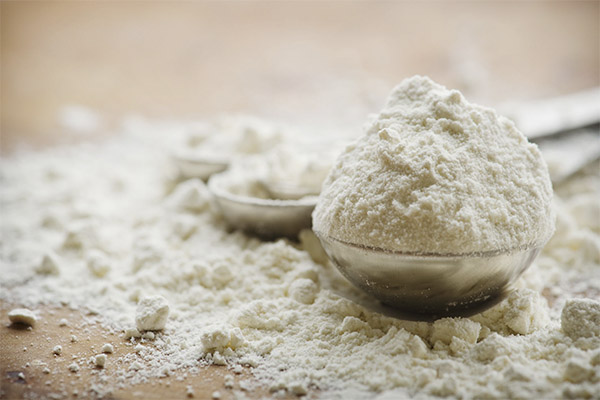
Rice flour is used to make:
- Tinctures to rub on skin for irritations, acne.
- Tonic to help tighten the skin, smooth out unevenness, make its texture soft and delicate.
- Hair rinses that improve elasticity and reduce the electrifying effect.
- Facial and body scrubs for even the driest and most sensitive skin, because fine rice flour has the softest texture and protects against allergic reactions.
- Facial and hair masks, wraps with the addition of honey, herbal infusions and essential oils, as well as massage mixtures that effectively draw out salts, warm the skin, contributing to the elimination of cellulite, rejuvenation, skin brightening and cell renewal.
Also on the basis of rice flour make excellent remedies for wrinkles and age spots, relevant for aging skin and pregnancy.
Rice-based homemade remedies are practically harmless and perfectly suitable for all skin types, reducing excessive oiliness, moisturizing, restoring elasticity and fighting rashes.
This ingredient is also added to industrial cosmetics. For centuries the ancient recipes have been used by Asian women, and today European and Western manufacturers make gorgeous body care products with rice flour.
Rice flour face masks
Lightweight, hypoallergenic rice flour masks are a great way to gently cleanse the skin. They draw out all the dirt from the pores, get rid of comedones, making the skin smooth and silky, keeping it moist and relieving irritation. The effect of the rice mask is similar to the clay mask, with this product being much more accessible and always on hand, because you can grind the flour at home.
- For rejuvenation, mix 2 tsp. olive oil, 1 tsp. honey, 2 tbsp. flour and some cream or sour cream to get a comfortable consistency. The mixture of oil and honey can be preheated in a water bath for a better effect. Apply the mask for 20 minutes, repeat the procedure three times a week for a month.
- To make a gentle scrub, mix flour with water in a 1:4 ratio, add a little soothing oil, such as lavender or calendula, and a small amount of shower gel if you want to apply a body scrub, or milk for washing. This kind of gentle scrub is suitable even for dry and sensitive skin.
Hair Masks
- To strengthen hair follicles and improve hair growth, as well as to reduce the greasiness of the scalp, you can 3-4 spoonfuls of flour dissolve in warm water, infuse a little, add a couple of drops of grapefruit oil and apply to the hair, massaging the area near the roots. After a few minutes the mask should be washed with herbal decoction or water with lemon juice - this will provide shine of the hair. Useful tip: blonde hair can use rice flour as a dry shampoo. It will absorb excess grease well without weighing down the hair, and will help to get out of the situation in the absence of water.
- Strengthen and nourish the hair will help mask on coconut milk. It should be dissolved a little flour in a ratio of 3:1, apply it to wet hair and hold for 15-20 minutes, then rinse them with a light shampoo solution. Such a mask will help seal the ends and make the hair soft and manageable.
Harms and contraindications
The product is considered virtually harmless, so it can be consumed in any diet. The only exception is the presence of an allergy to the rice product, which is extremely rare.
However, in order for rice flour to bring only benefits, it is necessary to consider a few nuances.
- Rice is a fortifying product. If you are prone to constipation or hemorrhoids, it is better to limit its consumption.
- Rice flour has a medium caloric value, so dishes cooked with its addition, you need to eat small portions.
- In cases of gastrointestinal diseases, kidney failure and other acute ailments, it is necessary to consult with the attending physician about the dietary regimen with added rice.
How to make rice flour at home
To avoid overpaying for branded products, you can make rice flour yourself. To do this, you can use a blender or coffee grinder, selecting a suitable mode. Before processing, rice should be sorted, washed and dried on paper. Thermal treatment of grains does not require.
How to choose and store rice flour
If you prefer to buy ready-made rice flour, pay attention to its packaging. It should be airtight and tight, so that the product does not absorb extraneous odors and moisture. A cardboard bag is not suitable in this case.
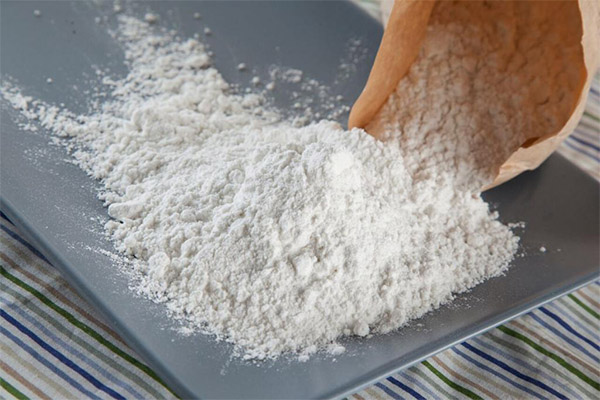
The flour should be dry, without lumps, homogeneous and have a uniform color: white or a shade of burnt sugar for brown rice. Brown flour can be stored for about 5 months because of its high oil and natural moisture content. Therefore, pay attention to the expiration date indicated on the package. There are no strict deadlines for white flour.
If you have had white flour uncovered for a long time, or if it has become moist, you can let it glaze it, thus prolonging its usefulness. But if an unpleasant stale smell has appeared, it is better to throw the product away.
Keeping flour in an open bag is not recommended. It is better to pour it into a glass, ceramic or plastic jar with a tightly closed lid to protect the product from moisture. Flour mites or fungi can cause allergic reactions in the body, so avoid spoiling the flour product.
What you can make with rice flour: recipes
In pure form, baking from rice flour does not work, since the grain has no plastic properties. Therefore, dough is made with eggs or with the addition of starch. A corn-based version would work best. Adding bananas or mixing with flour from other grains can also help.
Gluten-free rice pancakes
To prepare a dietary snack, you will need:
- rice flour - 250 g;
- table starch - 25 g
- sugar - 50 gr;
- milk - 0,5 l;
- vegetable oil - 45 ml;
- chicken eggs - 2 pcs;
- salt to taste.
Proponents of healthy eating also use coconut milk in this recipe. The principle of cooking - as with conventional pancakes.
Cheesecakes for Vegans
You will need 1 banana, 200 g of tofu, 1.5-2 spoons of rice flour, salt, sugar and cinnamon to taste. Grate the cheese and banana or mash with a fork, then add the flour and spices and knead the dough. Fry cheesecakes in oil for a couple of minutes, the recipe is suitable for breakfast.
Rice Krispie Treats from Asia
To make an unusual dessert, you will need:
- powdered sugar - 125-150 g;
- rice flour - 100 grams;
- chicken egg - 1 pc;
- hazelnut - 45 g;
- half a spoon of baking powder;
- grated fresh ginger - 2 tablespoons.
First you need to beat eggs with sugar, then add grated hazelnuts and ginger, dry products, mix everything thoroughly and roll out the dough into neat balls. Bake the cookies on a greased baking tray for 10-15 minutes at 180 degrees.
Dessert bread is prepared as follows: 2 parts butter, 2 parts wheat flour, 1 part rice flour and 1 part brown sugar. First, the butter is beaten with sugar, then the sifted flour is added, kneading the dough, cooling it for about half an hour. Then make 2 sheets of dough, cut them with a knife, like a pizza, into 6-8 pieces, put one layer on a baking tray, pour sugar over it, cover with the second layer and bake for about 20 minutes. After that, the triangles are separated from each other and let the bread cool.
Fritters
For the pancakes you need to take 1.5 cups of rice and 2 tbsp. Flax flour, 2 teaspoons of baking powder, 2 eggs and a cup and a half of milk.
To prepare tortillas, you need to mix 1 egg, a teaspoon of vegetable oil, a spoonful of sugar and salt, 350 grams of flour, 2/3 cup of water. From the resulting dough roll out thin round sheets and fry them on a greased frying pan, after which you can wrap any filling in them.
Banana Muffins
Banana muffins on rice flour can be made with the following components: banana pulp - 80 g, rice flour - 50 g, a spoonful of non-fat yogurt, 1 egg, half a spoon of baking powder and vanilla to taste. Bake the muffins for about 20 minutes.
Rice Facts
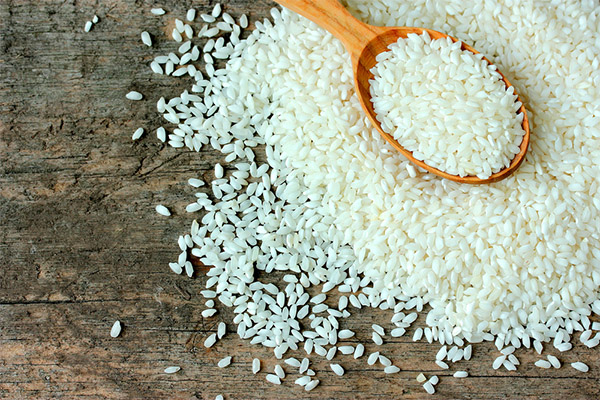
- Rice is a very durable material. During the feud between China and the Mongol tribes, rice flour was added to the mortar during the construction of the Great Wall of China to make it stronger. The same technology was used for many years to build houses and make bricks.
- In health food stores you can find flour made from wild black rice. It should be understood that this is the name of a plant that in fact has nothing to do with the original grain, so the beneficial properties of rice will not apply to black rice flour.
- Rice flour has been used for centuries as an antibacterial powder. It was started by geishas, after which it was picked up by aristocrats, artists, and then all the beauties of Asia. Today, rice flour can be found among the ingredients of powder products. It keeps pores tight, protects the skin from impurities and relieves irritation.
Rice flour is a perfectly safe and affordable product that will help maintain health and diversify your diet, so try new recipes with pleasure!
«Important: All information on this site is provided for informational purposes only. purposes. Consult with your health care professional before applying any recommendations. specialist before using the recommendations. Neither the editors nor the authors shall be liable for any possible harm caused by materials."

